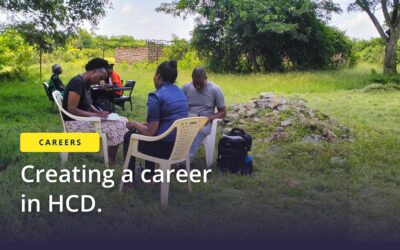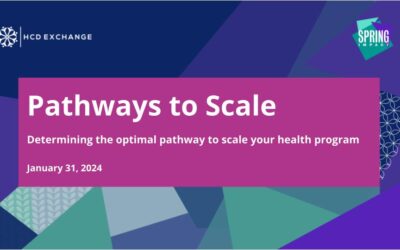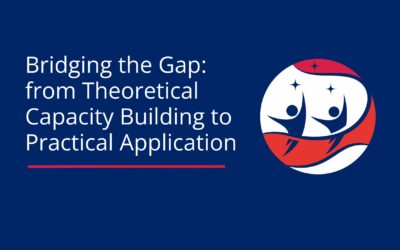Can you talk more about Empathways in the Nourishing Connections tool. How did you get the audience interested in using/opening the tool? And what was the experience prototyping during the HCD process?
- Empathways is a valuable tool designed to create a safe and empathetic space for communication between caregivers and community health workers (CHWs). It aims to foster a connection, promote open dialogue, and enhance the efficiency of counseling sessions. Here’s a bit more detail about how we got the audience interested in using and opening the tool and our experience with prototyping during the HCD process:
- We introduced Empathways as a tool to enhance the communication and relationship-building aspect of counseling sessions. We emphasized that it would help CHWs establish trust and rapport with caregivers, leading to more productive discussions.
- We highlighted the benefits of using Empathways, such as more open and honest conversations, active listening, and shorter counseling durations. We stressed that it would create a safe and empathetic environment for caregivers to share information.
- To engage our audience, we conducted training sessions or workshops that involved role-playing scenarios using Empathways. This hands-on experience allowed CHWs to see the tool in action and understand its practical value.
- Prototyping Empathways was an iterative process. We started with initial concepts and gradually refined them based on feedback from CHWs, caregivers, and other stakeholders.
- We actively sought feedback throughout the prototyping process. We conducted pilot sessions where CHWs used Empathways in real-life counseling situations. This feedback helped us adjust the tool’s content and structure. We adopted videos that were played during CHWs training to prompt their empathy followed by sharing practical communication tactics important during counseling sessions.
- We observed how CHWs and caregivers responded to the tool during the prototyping phase. Their reactions and the effectiveness of Empathways in building empathy guided our adaptations and refinements.
- We ensured that CHWs were well-trained in using Empathways effectively. This included providing guidance on how to use the questions and prompts in a way that fosters empathy and trust.
- Empathways were adapted to the specific needs and cultural context of the community. This customization was an essential part of the prototyping process to ensure it resonated with the target audience.
Can we have a mixed approach of HCD into SBCC at once in a project? If yes, how can we measure the impact, whether it is the outcome of SBC or HCD?
- Yes, it is possible to have a mixed approach of HCD integrated into SBC within a project. This combination can enhance the effectiveness of SBC by ensuring that the strategies are better tailored to the needs, preferences, and behaviors of the target audience. To measure the impact of the approach and determine whether the outcomes are a result of SBC, some qualitative feedback can be useful both at baseline, during testing, and after applying prototypes. It is also important to allow room for changes and adaptations to be made based on learning.
What are some of your practical considerations for integrating HCD into SBC?
- Although other participatory methods are well known in public health, HCD brings stakeholders along for the entire process – in order for this to be possible we need to remain flexible to the nuances of the approach and stay flexible along the way. Also, HCD is needed to translate the meaning of some of the terms and jargon from other methodologies.
What strategies would promote the “mindset change” in relation to Community Health Workers from rural communities, considering there is a traditional “top-down” approach?
- In our efforts, we noticed a transformation when we introduced videos featuring uplifting messages that motivated Community Health Workers (CHWs). This transformation doesn’t occur instantly, much like any desired change. CHWs encounter various challenges along the way. To support their progress, we consistently demonstrated how mothers benefit when they receive help, which in turn motivates CHWs to apply their newly acquired skills. This sense of pride and appreciation reinforces the value they bring.
How do you get community members to stay the course and be involved throughout the whole process?
- Part of the incentive process was to engage individuals already working in care groups – so they were incentivized as they were already doing this but there were standard incentives for example there was cooking oil given to participants to provide their feedback. They did continue to engage without incentive which speaks to them finding value in the process and their participation had been made clear to them.
When we go into these communities how do you identify and address the hard-to-change cultural norms?
- HCD brings this value-add as it gives you the opportunity to walk in the participants’ shoes and they are part of the solution so it’s an approach that takes time, dedication, and understanding. For example, the card game made for dietary diversity – there was some resistance as it was seen as going against their culture but now it has been taken up by many members which has made it an exciting learning tool. It is also important to understand that the HCD process takes time – care group members developed a card game that enables them to recognize a norm and then work with family members to co-create a solution over time.
I wonder how you operationalize HCD in terms of sample size and representation across the different stages of SBC? In other words, how to ensure we hear from a good number and diverse set of say, CHWs, in HCD processes?
- HCD, like many other qualitative research methods, typically has fewer research participants compared to a quantitative study. As such, within HCD, we first want to understand the type of users involved in the problem at hand and this is done by having kick-off meetings with the client to understand the context of the problem, stakeholders involved, expected outcomes, etc. Through this discussion and our analysis of the information we receive from the client, we’re able to identify the different sets of views we would like to receive in order to co-develop a comprehensive solution. In the case of CHW, we would want to hear from those working in different contexts, geography, gender of the CHW, religion, and any other key attribute that would help us explore the problem more. From this, we would design our research to ensure we speak to at least 3 CHWs representing each attribute of interest. After a certain number of interactions (interviews, observations, focus groups), we can ascertain that we have reached theoretical saturation – a point where we believe there’s no new information to learn as we’re receiving information that we would have heard about already.
Did you work with community health workers who are already part of the health system? If yes, did you provide additional incentives (on top of what they are used to)? Do you foresee any scale-up barriers related to CHW incentives as in most contexts, these are volunteers who sometimes lack the motivation to keep delivering?
- Yes, we did work with a few community health workers who are part of the government system, but in this context, we primarily worked with community volunteers who are not formally on the government payroll. We provided stipends to compensate community volunteers, particularly for home visits. However, community volunteers are often supported by various community structures, this motivates them too. This collaborative approach, which included other forms of motivation beyond finances as well as community support, continuously helps to ensure the sustained involvement of the volunteers. We are also working with the government to engage our trained community volunteers in the Community Health Influencers and Promoters (CHIPS) program across the country.
I am very familiar with care group methodology – and curious about what “new” and “unexpected” discoveries came out of the HCD work with care groups. Can you detail deviations from the regular CG criteria – that came out from the HCD work? What unexpected discoveries (using Riley’s words) can you mention?
- Variable Structure: We found that each implementing partner had adapted the care group model to meet guidelines adopted by the national government. The core difference is that a care group in Zimbabwe consisted of a group of between four and ten “neighbor mothers” or caregivers of children under 5 led by a volunteer facilitator known as a “Lead Mother”. This group would meet regularly, typically twice a month, and lead mothers would conduct household visits (which began during Phase 2 of our research). Lead Mothers were selected and supervised by Care Group Promoters, formally known as community health volunteers. In Malawi, a care group consisted of a Care Group Promoter leading a group of 8 to 12 “Cluster Leaders”. Cluster leaders support 8 to 12 households, but caregivers in these households generally do not meet as a group.
Our key learnings were:
- Care groups should have fun! Care group members value group unity and cohesion as key elements of a quality care group. Building on these insights, each solution was drafted to include at least one element intended to increase interactions between members during a care group meeting. These included new welcome activities and games, singing, and dancing among others. After testing these new activities, participants reported feeling more comfortable and a higher willingness to engage during and after “fun” activities, representing a real opportunity to strengthen dialogic exchange from member to member and member-to-Lead Mother.
- Don’t neglect soft skills. We know that quality counseling requires more than technical knowledge. Soft skills such as teamwork, problem-solving and critical thinking, communication, adaptability, time management, and interpersonal interaction are necessary. After trying co-created activities in the “Simple Job Aid for Facilitation Skills Session”, participants generally reported feeling more comfortable and a willingness to try new ways of interacting with household beneficiaries.
- Care groups can learn from and support each other. Care group participants expressed interest in learning from one another and supporting each other with common challenges. The “look-and-learn” prototypes in Zimbabwe and Malawi were well received across communities because they supported the leaders with new ways of leading their sessions based on observing another leader during their session.
- Community ownership is a key enabling factor for care group implementation. Community ownership and linkages are key factors in community support for the implementation of care groups as well as key to all conceptualizations of sustainability in both Zimbabwe and Malawi. During testing and iteration of the “Community Leaders’ Aid for Supporting Care Group Quality” in Malawi, community leaders appreciated the participatory approach and showed enthusiasm for their new-found role in supporting and fully understanding the care groups.
- Family support is a key factor for care group participation. Care group participants in Zimbabwe, care group members, and Lead Mothers emphasized that family support was both a key facilitator and a key barrier to participation. Implementing partners could consider exploring family support as a factor and using a co-creation design process like HCD to determine the approach and implement it to strengthen family support.
With the implementation of the Care Group approach in MALAWI and ZIMBABWE, have you used other approaches that facilitated accountability between community members and care providers? e.g.: the CVA (Citizens’ Voice Actions) approach or another approach strengthening accountability?
- While we did not use the CVA approach, we did co-design an approach with community leaders in Malawi which we’ve called “Community Leaders’ Aid for Supporting Care Group Quality”. That prototype will be publicly accessible on the USAID Advancing Nutrition website (https://www.advancingnutrition.org/) in the coming weeks.
- During the study, the Amalima Loko program in Zimbabwe also started implementing a community dialogue approach to strengthen accountability, and ownership, and generate inputs for their sustainability plans.
The iterative approach requires time which we do not often have in project-funded research. On average, how long did it take to start seeing a change in the communities you have intervened in? How do you maintain their engagement throughout the process?
- Participants reported that they had started adopting and adapting concepts immediately following a sensitization workshop that launched in Phase 2 of both studies. While participants were enthusiastic about the perceived impact of using the prototypes during testing and iteration, we were not able to measure the impact in either study. It was not part of the HCD design in Zimbabwe, and we encountered implementation delays in Malawi that resulted in the cancellation of the third phase (evaluation) of the approach adapted from the living labs methodology. Researchers and partners considering similar participatory design approaches should consider timelines and resources needed for the design process and any prototypes that result from it.
I would like to ask about any experiences where you were able to ‘institutionalize’ changes to a widely endorsed government approach or intervention at a larger scale? For example was BA able to scale this up at the state level in Nigeria? To me, advocacy may be needed to ensure these changes that are produced by HCD can be sustained after the project ends.
- In Nigeria, we’ve had some promising experiences where the government in some of the implementing States (provinces) has shown interest in adopting the approaches that emerged from the HCD process. For instance, the card game garnered their attention, and they were keen on scaling it up. We also took steps to build the capacity of our government partners. However, despite their willingness, scaling up these approaches has faced challenges, primarily due to funding constraints.
- Another noteworthy example is the integration of components from the nourishing connection tools (the trivia and action planner) into the Maternal Infant and Young Child Nutrition national training manual. This integration represents a significant step toward institutionalizing changes at a larger scale, with the potential for broader impact.
Did you feel the tools used were adequate in changing these types of behaviors? Please share any lessons you garnered on this.
- Yes, I will say they are effective. Like every kind of change, it takes time and could be challenging to change behaviors. However, the tools provide an opportunity to address the unique needs of families and provide the needed support. For example, one Mother’s concern was that food preparation was stressful. Once this was identified, together with the CHW, they worked out a way to prepare the family food such that the child on complementary feeding is able to eat as well. They also worked out how other members of the family could support in child care.
Are HCD initiatives always involving some kind of ‘product’ or tool, like the cards and printed materials shown in some photos? What are the costs and sustainability issues with these materials?
- Not all HCD initiatives are focused on physical products. Some are built on a solution that is focused on an experience or service that the user receives. As such, no physical product or tool is developed. In cases where a product is built, the sustainability of that solution is something that would’ve been considered by the designers and the implementing partner. The initial costs of a product or tool may be covered by the implementing partner but ownership or continuation of the use of the tool will be handled by the community or relevant government body. Mechanisms are built to continue financing the use of the product, should there be need to, within the community or government body such as a budget line dedicated to that intervention or income-generating activities. In some programming cases, another implementing partner may take over the intervention and finance the implementation and iteration of the product.




